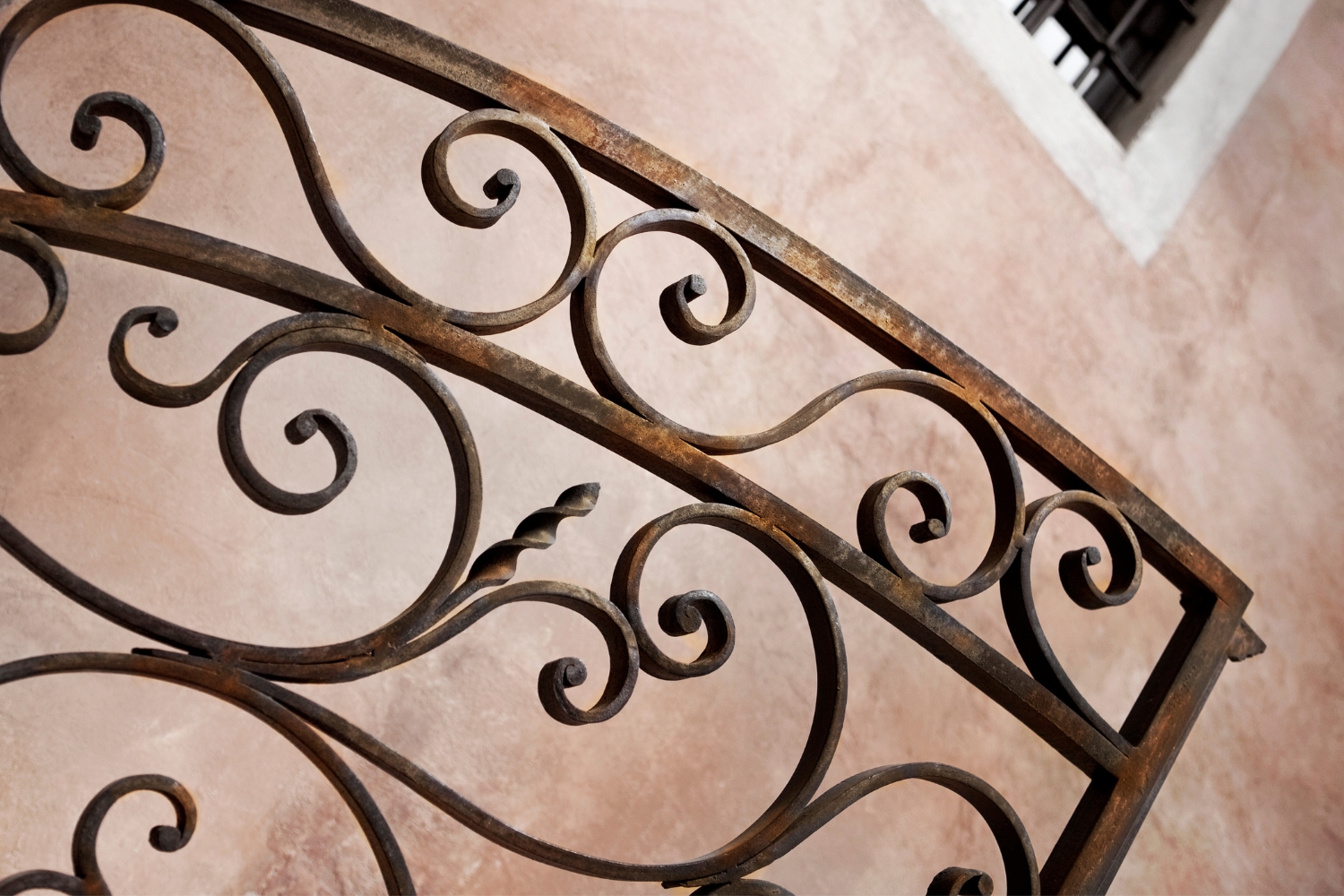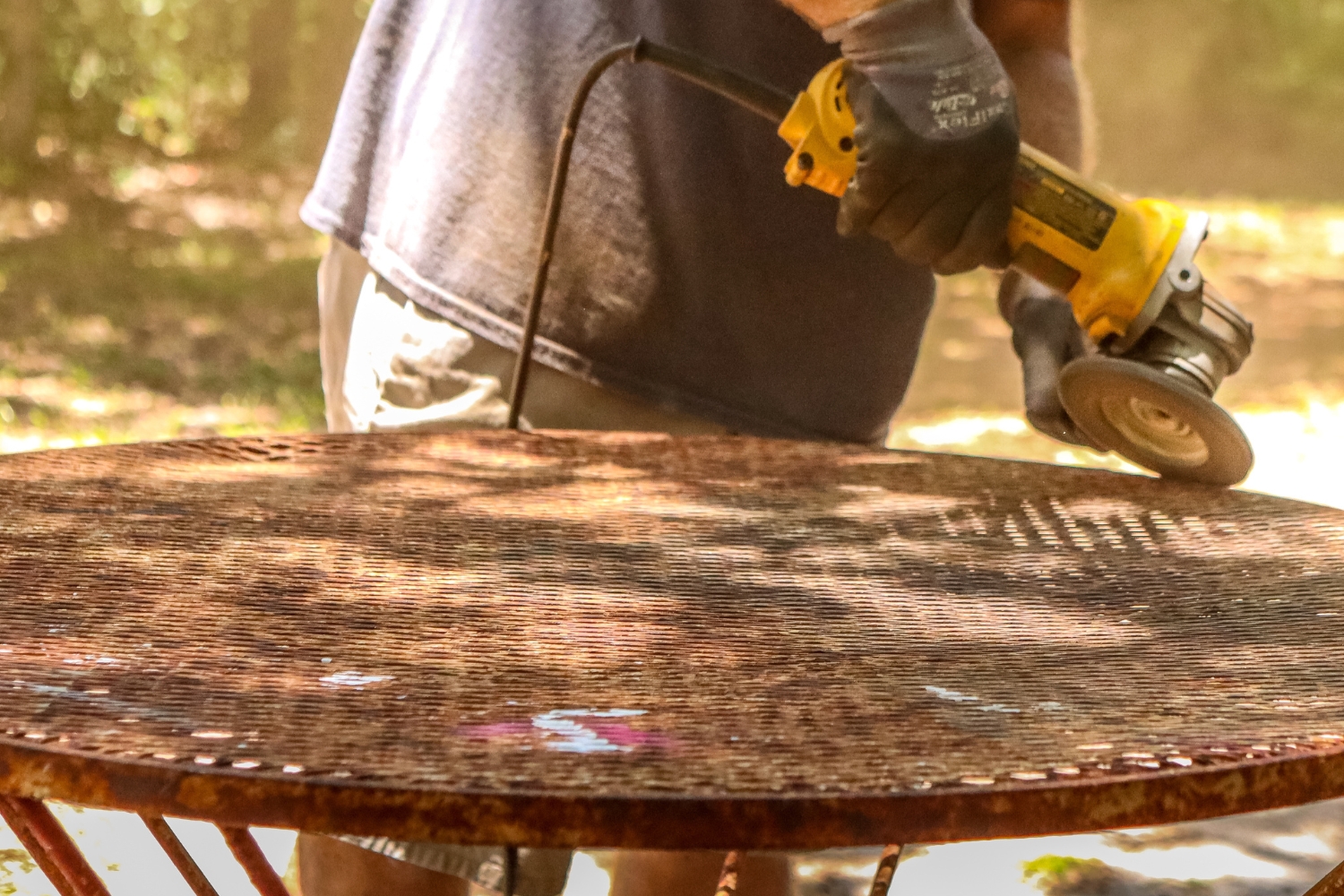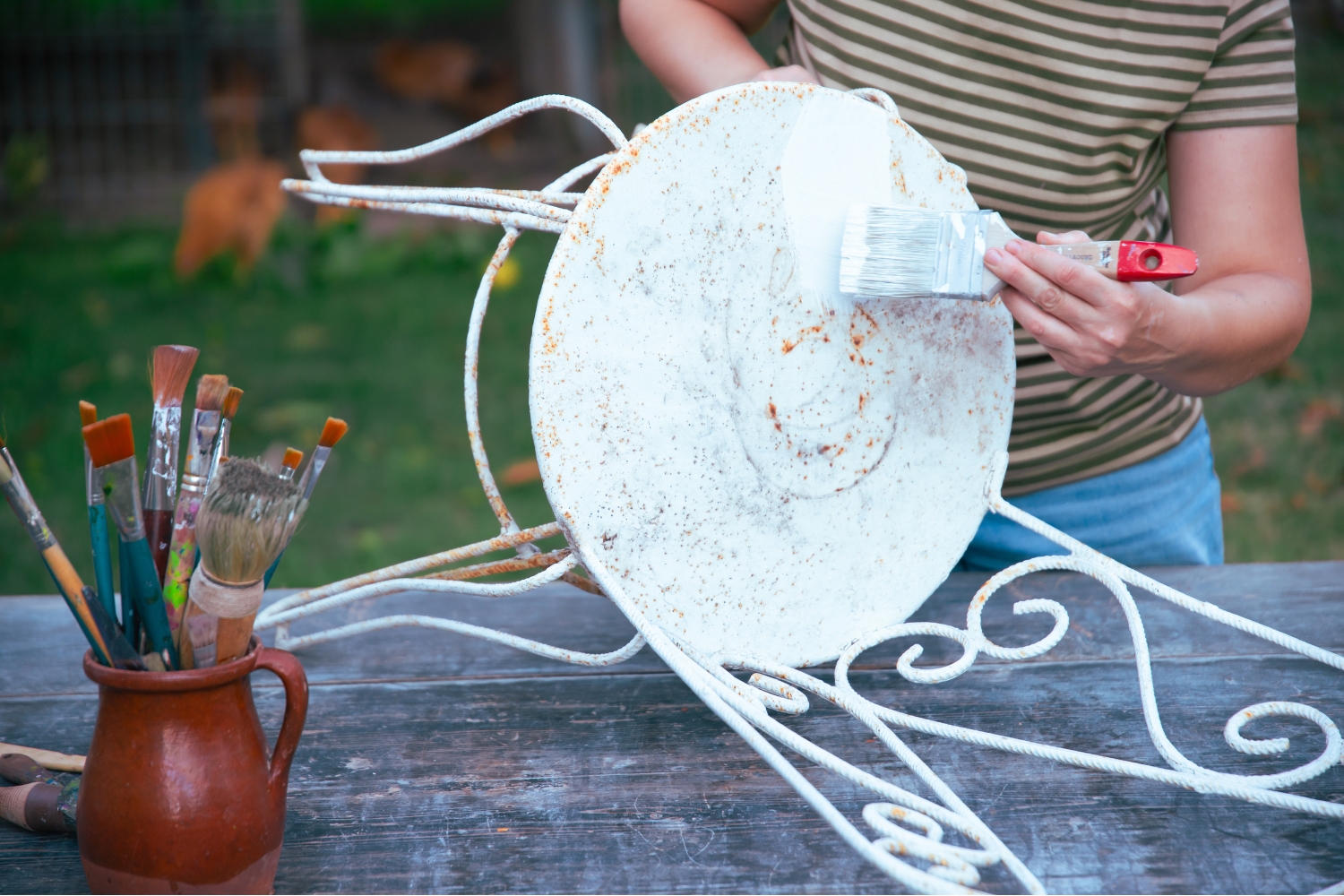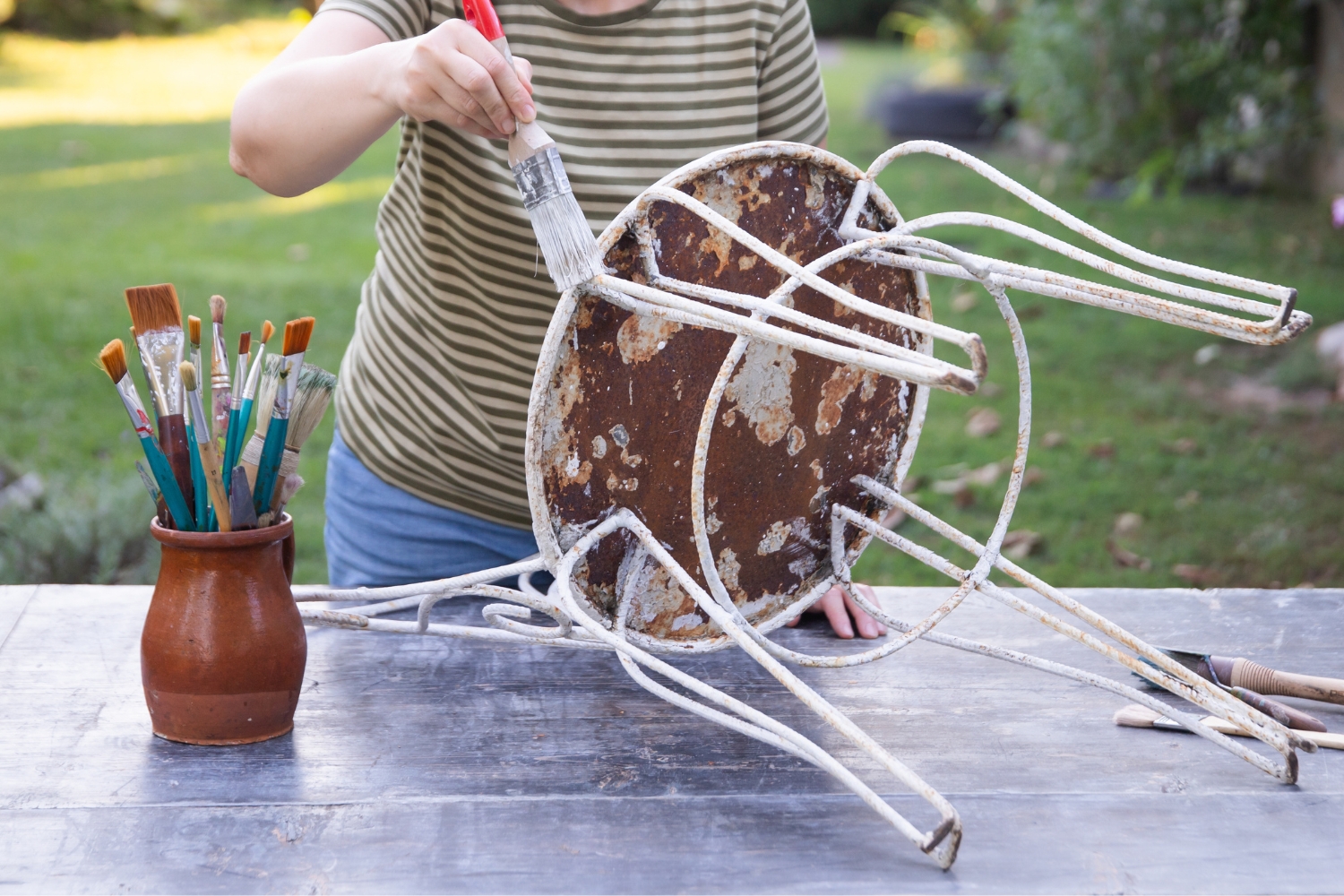Wrought iron furniture is beautiful, durable, and timeless, but when rust shows up, it can quickly steal away its charm. Luckily, restoring your pieces can be done in the comfort of your own home!
Bring back the smooth finish and protect your handcrafted wrought iron furniture for longer with these maintenance tips for wrought iron furniture. We’ll walk you through five clear steps to remove rust from wrought iron (click to jump to steps) safely and effectively.
Why Does Wrought Iron Rust?
Similar to other metals, rust forms when moisture and oxygen react with the surface of iron. This is known as iron oxide, which is a type of electrochemical reaction. Outdoor pieces are especially vulnerable because they’re exposed to rain, humidity, and even morning dew. But, even indoor pieces can start to rust if they’re in damp areas, like basements. Once rust gets a hold of your wrought iron king bed or other wrought iron pieces, it spreads fast if left untreated. This is why catching the rust fast and taking care of it before it takes over is essential in iron furniture maintenance.

Before You Begin Cleaning Your Wrought Iron Furniture
This guide will set you up for success with tools and materials, safety measures, and a step-by-step guide to cleaning rust off of your wrought iron furniture.
Tools and Materials You’ll Need To Remove Rust
Before you start, gather everything in one place so the process goes smoothly:
- Wire brush or steel wool
- Sandpaper (medium and fine grit)
- Mild dish soap (Dawn, Palmolive, or other reputable brands will work)
- Bucket and sponge
- White vinegar or rust remover solution
- Clean rags
- Wrought iron-safe rust-inhibiting primer and paint or sealant
- Gloves, safety goggles, and a dust mask
DIY vs. Store-Bought Rust Removers
When it comes to actually breaking down rust before scrubbing it off, you’ve got options:
| Option | Examples | Pros | Cons |
| DIY Methods | White vinegar, lemon juice, and baking soda paste |
|
Takes longer, may need multiple applications |
| Store-Bought Products | Commercial rust remover sprays or gels | Fast results, strong enough for tough rust |
|
Safety Tips Before You Start Removing Rust From Your Iron Furniture
Working with rust and chemicals can get messy. Here’s how to keep yourself protected when cleaning your wrought iron furniture:
- Wear gloves to protect your hands from sharp edges and chemical solutions.
- Use goggles and a mask when sanding or scrubbing to avoid breathing in dust.
- If you’re using chemical rust removers, make sure you’re in a well-ventilated area or outdoors so that it doesn’t overwhelm your home with dangerous fumes.
- Keep a bucket of clean water and soap nearby in case you spill anything.
Both can help you remove rust from wrought iron, so it comes down to your comfort level and what you already have at home.
Step-by-Step Guide To Removing Rust From Wrought Iron Furniture
Here are the five key steps we recommend as wrought iron blacksmiths:
Step 1: Scrub Off Loose Rust
Start with a stiff wire brush or sandpaper. Gently scrub the surface to remove flaky rust and any loose paint. Focus on getting into the corners and curves; those hidden spots are where rust loves to hide.
Be mindful not to get too harsh with the furniture; this step is meant to remove rust and loose paint, not the metal itself.

Step 2: Wash the Surface
Mix warm water with a few drops of mild dish soap. The amount for this doesn’t have to be exact; it’s more about creating a soapy solution that loosens dirt. Using a sponge or cloth, gently wash the entire piece to remove dust, dirt, and small rust particles that you lifted in the previous step. Rinse your sponge, cloth, and furniture with clean water (no soap) and let it dry completely before moving to the next step.
Step 3: Apply a Rust Remover or Vinegar
For stubborn spots, you can use a store-bought rust remover or a simple DIY method: soak a rag in white vinegar and place it on the rusty area. Leave it for about 30 minutes to let it soak a bit, then scrub again with steel wool or a brush. This helps remove rust from wrought iron that doesn’t come off with just sanding.
Step 4: Smooth the Surface
Once the rust is gone, lightly sand the surface again with fine-grit sandpaper. Again, be gentle with this part. While the rust is gone, we’re not trying to remove any metal. This evens out rough patches and prepares the furniture for a protective finish. Wipe everything down with a damp cloth to remove dust.
Step 5: Protect With Paint or Sealant
The best way to stop rust from coming back is to seal the surface. Apply a coat of rust-inhibiting primer, followed by outdoor metal paint or a clear protective sealant. This locks out moisture and helps your piece stay rust-free for years!

Preventing Rust From Coming Back To Your Wrought Iron
Once you’ve put in the work to remove rust from wrought iron, the key is keeping it that way. Rust loves moisture, so your main goal is to keep surfaces dry and protected. Here’s how:
- Wipe Down After Rain or Humidity: Even a thin layer of water can start the rusting process. A quick wipe with a dry cloth after rain, dew, or even a humid day goes a long way in prevention.
- Use Covers Outdoors: If your wrought iron stays outside year-round, invest in breathable furniture covers. These keep moisture off but still allow air to circulate, which prevents condensation buildup underneath the cover.
- Store Indoors for Winter: Cold weather itself doesn’t cause rust, but snow, ice, and road salt in the air can speed up the process. If possible, move your furniture into a garage, shed, or basement during the off-season.
- Reapply Primer, Paint, or Sealant: Think of paint and sealant as the armor protecting your wrought iron. Every couple of years, inspect for chips or cracks and touch them up in the same way we mentioned above. Even small spots left bare can become rusty so take care of them as soon as possible.
Common Mistakes to Avoid When Cleaning Wrought Iron
When trying to remove rust from wrought iron, even small missteps can undo all your hard work. Here are the biggest pitfalls we’ve seen people run into and how to avoid them:
Skipping Primer Before Painting Your Wrought Iron Furniture
Primer isn’t just “extra paint.” It’s a bonding layer that seals the wrought iron and stops moisture from sneaking through. Without it, rust can creep back under your paint within months.
Not Fully Drying the Wrought Iron’s Surface
After washing or scrubbing, any leftover moisture trapped under paint or sealant will cause bubbles and rust to form again. Always let the piece air-dry completely before coating.
Using the Wrong Sandpaper on Wrought Iron
Coarse sandpaper can scratch the surface too deeply, while overly fine paper won’t actually remove the rust. Medium grit (80 to 120) works best for the first round, followed by fine grit (150 to 220) to smooth things out.
Ignoring Small Rust Spots on Your Furniture
Specks might not seem like a big deal, but rust spreads quickly. If you see orange spots or bubbling paint, deal with them right away before they grow into larger problem areas.
Avoid these mistakes and extend the life of your wrought iron furniture for decades.

Keeping Your Wrought Iron Rust-Free
Trust us, the sooner you remove rust from your wrought iron, the better. These pieces are built to last for generations, which is why so many families pass them down as heirlooms. A little routine care and knowing how rust behaves can make all the difference. Stay on top of small spots and practice good prevention, and you’ll be enjoying your wrought iron for decades to come!